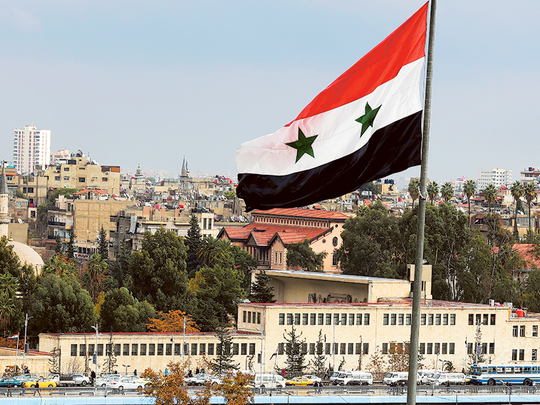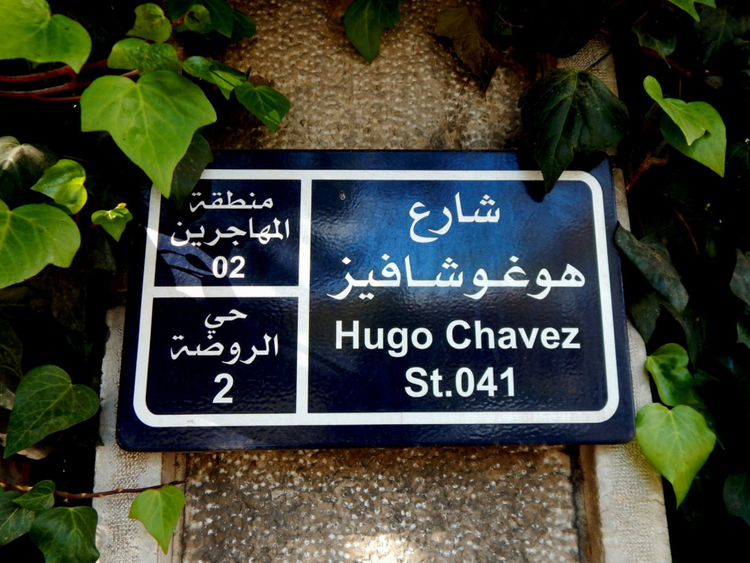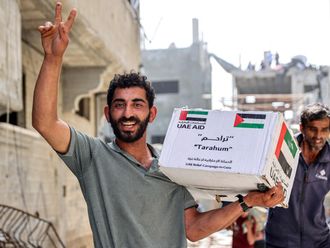
Beirut: Residents of upscale Damascus in the habit of morning strolls near public parks were not surprised when municipality workers took down a blue signpost near the Al Rawda neighbourhood, with the words, “King Abdul Aziz Al Saud Street, founder of the kingdom of Saudi Arabia.”
The street got its name in 1953, shortly after Abdul Aziz’s death, on the orders of then-President Adib Al Shishakli, who enjoyed warm relations with Saudi Arabia.
The street was renamed “Hugo Chavez” in a slight to Saudi Arabia, who has been a staunch backer of Syria’s opposition.
Damascus Municipality worker Intissar Mansour told Gulf News that more streets, schools, parks and squares were under consideration for renaming.
“Some names are no longer relevant to modern times,” she said as she pointed to Omar Shakhasiro High School.
The school was named after a high ranking intellectual who briefly served as Minister of Culture in 1962.
Hafez Al Assad’s Baathist regime never liked him, because he was critical of the short-lived Syria-Egypt Union from 1958-1961.
His name was simply scrapped off and the school was renamed “Sawa”, in reference to a campaign slogan used by the president’s supporters during the elections of 2014.
Over the past few months, over 30 schools have been renamed after soldiers and officers in the Syrian Army, including Ibn Taymiya School on the slopes of Mount Qassioun overlooking the Syrian capital, originally named in honour of the 13th century Islamic scholar whose hardline thought formed the crux of Wahabi ideology in Saudi Arabia.
The school is now called “Sergeant Ahmad Fayek Al Kurdi School.”
The name-changing is a two way tool practised by both Damascus and the Syrian opposition, going hand-in-hand with changing the flag and trying to change the national anthem as well. When they overran the strategic town of Daraya in the Damascus countryside in 2012, they tore down all presidential statues and streets named after Baathist officials, notably one called “Basel Al Assad” after Hafez Al Assad’s son who died in a car accident in 1994. They renamed the street, “Giath Matar” honouring a civil activist from Daraya who was killed in jail in September 2011.
That signpost was immediately taken down by government troops when they entered Daraya last October.
Five years ago, opposition activists even temporarily changed the names of streets and bridges on Google Maps, removing all mention of Hafez and Bashar Al Assad. They changed the name of the Assad National Library in Damascus and Jisr Al Thawra, a bridge commemorating the Baath Party coup of 1963, calling it “Jisr Al Huriya” (Freedom Bridge).
Within Daesh-held villages and towns along the Euphrates River, all schools named after Baathist figures or secular Syrian intellectuals were renamed after companions of the Prophet or battles from the early stages of Islam.
“Hafez Al Assad Street” was renamed, “Omar Ibn Al Khattab Street” and “6 October School” in Raqqa, named after the October War of 1973, is now named after the Battle of Badr of 624, a decisive battle in Muslim history that is one of the few explicitly mentioned ones in the Holy Quran.
George Khoury, a retired mathematics instructor at a state-run high school in central Damascus, told Gulf News: “I am in my 70s. I have seen the names of schools and streets changed time and again during my lifetime, depending on political winds.”
He pointed to a street near the Syrian Parliament where he used to teach at a state-run school in the 1980s saying: “It was once called King Farouk Street. When he was toppled, the Syrian government quickly renamed it “Jamal Abdul Nasser.” When Nasser died, they hated Sadat and decided to change it to “Misr Street.”
Some Baathists are currently lobbying the Damascus Municipality to even change the names of places named after prominent Ottoman figures, like the 18th century governor of the city Midhat Pasha, whose name marks one of the city’s ancient bazaars, or the Sinan Pasha Mosque, named after the Ottoman governor of the city in 1589-1593.













